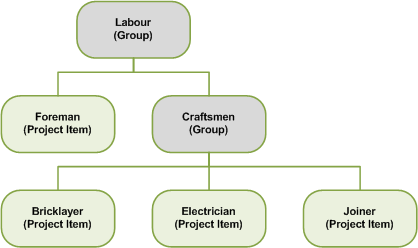Designing a project structure
The project structure that you design will depend on your type of business and the information you require about your projects. The project structure may be simple or quite complex, depending on your requirements. Before you set up your project structure, think very carefully about what you want to record and monitor in your projects.
Project structure
The project structure you will define in Project Accounting is organised in a tree structure. This structure is comprised using three different components:
Projects
Projects define a particular project or contract. In the project structure, a project level can define the entire project or a task in the project as a whole. You can report on projects and set budgets at the project level.
Examples of project levels could be: a VAT return prepared by an accountancy firm, a course provided by a training company, a job at a garage, a development at a construction firm, a campaign at a marketing company, or a contract at a cleaning company.
Groups
Groups are optional, and are used to group together related items in a logical structure. This allows you to analyse the costs for that group. In the project structure, each group is categorised by its grouping level. Unlike project levels, grouping levels that you define are not unique and may be used across a number of projects.
A project can contain main group activities that are further broken down into actual activities. For example, the project level of exhibition could include groups for venue hire, stand construction and catering. These groups would be used to relate the project items for each activity.
- For information on setting up grouping levels, see Define grouping levels.
- For information on setting up groups, see Set up project items.
The following grouping structure could be used for a house building project.
To build the substructure of the house, the activities are broken up into two groups of Ground Preparation and Foundations.
The Ground Preparation group contains a single activity of Labour - excavation. The Foundations group contains the activities of Labour - foundations, Concrete and Timber.
The activities are set up as project items in the structure, which you can post costs and revenues against. You do not post costs and revenues against group items, as they are used to group together other activities for analysis purposes. Project Accounting allows you to analyse costs at any level of the structure.
Project items
Project items are where you record and track costs and revenues in your project. These items can be categorised into different project item types, such as labour, materials and expenses. Each transaction recorded in your project must be assigned to a project item type. For example, the project item type of general expenses could include project items for hotel accommodation, taxi hire and meals.
Project items are used to monitor the costs and revenues involved for each project activity, and they will determine the degree of detail and analysis you can derive from Project Accounting. Project items can be used to define specific items or activities, or they can define phases on a project.
To monitor your project activities you need to:
- Decide on the project items that you require.
- Decide what level of detail is required for tracking activities.
- Decide how you are going to organise or group activities.
- Set up your project items and groups.
Project item coding method
Each project item has a code, which is a reference for that particular item or activity. You should consider what coding method to use for your project items, in much the same way that you must consider how to set up your project coding method. The considerations which apply to your choice of project numbering system (such as simple numbering or segmented numbering) can also apply to your choice of project item numbering system.
Using a combination of project item types and good item code numbering, you will be able to perform in-depth cost analysis to the level your business requires.
Determining what is a project, group or project item is key to setting up the project structure.
Every project must have a structure so that costs and revenues can be posted to it. The cost structure defines what activities make up the project. Items can be grouped together in the cost structure using groups. This allows you to have a multi-tiered level of analysis.
Before you run Project Accounting, you must think about and plan your structures. If you have projects that are similar, you can create project templates containing your different structures.
Organise your project structure
In general, there are two common methods of organising your structure. The method that you use will depend on your type of business and how you want to analyse and report on your project. These different methods are described in the following sections.
The category method approach is to organise the structure according to similar cost (or revenue) category areas and activities. An example of a simple grouping is displayed below:
The category method is best suited to subcontractors and businesses where the expenses are primarily internal (labour and expenses). This method is not well suited to businesses that need to track a number of subcontractors; or businesses that require costs and revenues to be analysed by activities or phases.
You can set up groups to represent phases, sub-phases, and activities. Using this method, you can organise your projects in a logical or chronological sequence of tasks that must be performed.
Project items in different areas can be grouped together. The landscaping example below illustrates grouping by phase. It includes two phases of Ground Preparation and Planting.
This method of organising projects is best suited to businesses where jobs tend to be of a long duration and which require grouping of costs and revenues for activities that involve more than one category area.
What do you want to do?
Examples



